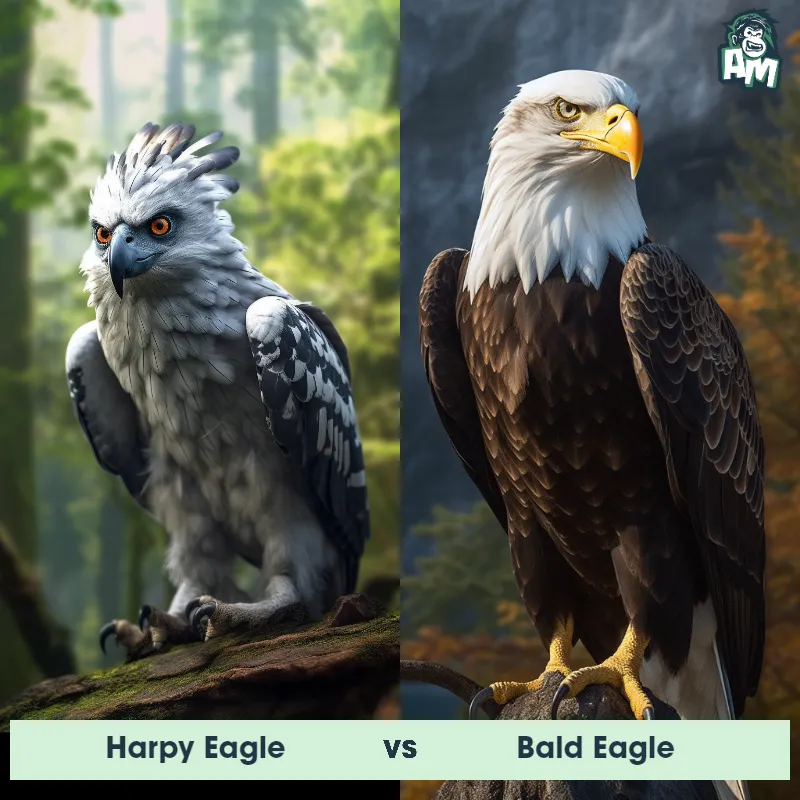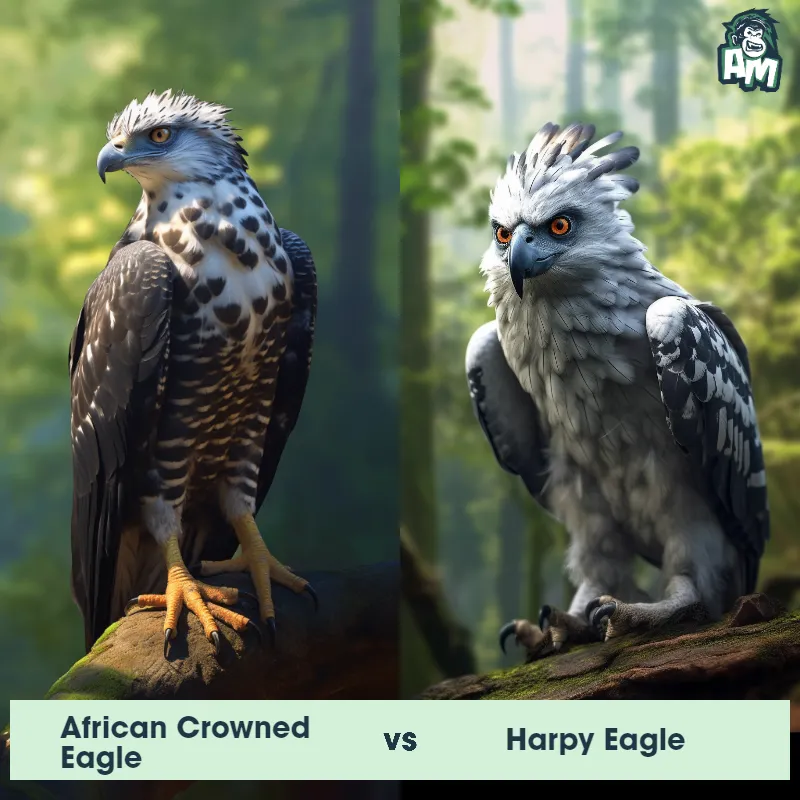The Harpy Eagle
The Harpy Eagle, also known as the American Harpy Eagle, is one of the largest and most powerful birds of prey in the world. It can be identified by its massive size, measuring up to 3 feet tall with a wingspan of 6.5 to 7.5 feet. Its overall appearance is striking, with a black crest on its head that resembles a crown and piercing yellow eyes. The harpy eagle is known for its muscular body, powerful beak, and long, sharp talons. It is a skilled hunter and predominantly preys on monkeys and sloths in the dense rainforests of Central and South America.

| Harpy Eagle | |
|---|---|
| Size | Up to 3.5 feet (106.7 cm) tall |
| Weight | Up to 20 pounds (9.1 kg) |
| Speed | Speed: 50 mph (80 km/hr) |
| Key Strength | Powerful hooked beak |
| Biggest Weakness | None |
| Scientific Name | Harpia harpyja |
| Family | Accipitridae |
| Habitat | Tropical rainforests |
| Geography | Central and South America |
| Diet | Monkeys, sloths, and other small mammals |
| Lifespan | 25 years - 35 years |

The Harpy Eagle
The Harpy Eagle, also known as the American Harpy Eagle, is one of the largest and most powerful birds of prey in the world. It can be identified by its massive size, measuring up to 3 feet tall with a wingspan of 6.5 to 7.5 feet. Its overall appearance is striking, with a black crest on its head that resembles a crown and piercing yellow eyes. The harpy eagle is known for its muscular body, powerful beak, and long, sharp talons. It is a skilled hunter and predominantly preys on monkeys and sloths in the dense rainforests of Central and South America.
Fun Fact: The Harpy Eagle has the strongest grip of any bird in the world, with its talons capable of exerting a pressure of up to 500 pounds of force, enabling it to snatch and carry away prey that weighs almost as much as itself.
| Harpy Eagle | |
|---|---|
| Size | Up to 3.5 feet (106.7 cm) tall |
| Weight | Up to 20 pounds (9.1 kg) |
| Speed | Speed: 50 mph (80 km/hr) |
| Key Strength | Powerful hooked beak |
| Biggest Weakness | None |
| Scientific Name | Harpia harpyja |
| Family | Accipitridae |
| Habitat | Tropical rainforests |
| Geography | Central and South America |
| Diet | Monkeys, sloths, and other small mammals |
| Lifespan | 25 years - 35 years |
Match Highlights
Harpy Eagle Matchups
We use AI to simulate matchups between the Harpy Eagle and other animals. Our simulation considers size, strength, and natural predatory behaviors to determine the most likely outcome.

Can't find the Matchup you want?
Create Your Own MatchupHarpy Eagle: Diet, Predators, Aggression, and Defensive Behaviors
What do Harpy Eagles eat?
Harpy Eagles primarily feed on small to medium-sized mammals such as monkeys, sloths, opossums, and even some larger animals like deer and agoutis. They are powerful predators that use their sharp talons to catch and kill their prey, which they often eat while perched high in the treetops.
Do Harpy Eagles have any predators?
Due to their large size and powerful predatory abilities, adult Harpy Eagles do not have many natural predators in the wild. However, younger eagles may be vulnerable to predation by larger birds of prey, such as other eagles or owls.
Are Harpy Eagles aggressive?
Harpy Eagles are known to be aggressive hunters when it comes to catching their prey, as they use their strong talons and sharp beaks to capture and subdue animals. However, they are not typically aggressive towards humans unless they feel threatened or are defending their nest.
Do Harpy Eagles fight?
Harpy Eagles are solitary birds for most of the year, except during the breeding season when they form pairs. During this time, they may engage in territorial disputes with other eagles over hunting grounds or nesting sites. These conflicts can sometimes escalate into physical fights, where the eagles use their talons and beaks to defend their territory.
How do Harpy Eagles defend themselves?
Harpy Eagles have several defense mechanisms to protect themselves from potential threats. Their large size, powerful talons, and sharp beaks make them formidable predators, capable of inflicting serious harm on any potential attackers. They are also known to be highly territorial birds, defending their nests fiercely against any intruders.
What is the biggest weakness of Harpy Eagles in a fight?
Despite their size and strength, Harpy Eagles have one significant weakness in a fight - their vulnerability to human threats. Habitat destruction, deforestation, and illegal hunting pose serious risks to the survival of Harpy Eagles in the wild. Conservation efforts are crucial to protecting these magnificent birds and ensuring their continued existence in the future.
Fun Fact: The harpy eagle has a highly adapted hearing system. It can rotate its head up to 180 degrees, allowing it to locate even the faintest sounds of its prey in the dense rainforest. This exceptional hearing ability helps it excel as an apex predator.
Fun Fact: The Harpy Eagle has distinct feather patterns. The coloration of its feathers blends with the surrounding foliage, making it highly camouflaged. From a distance, its feathers resemble broken branches or sunlight filtering through the canopy, allowing it to remain undetected while on the hunt.













































